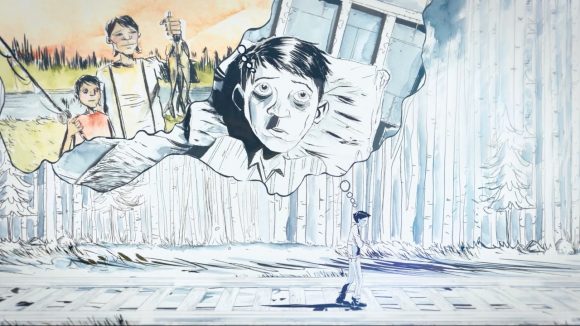Children in schools across Canada are learning about the Indian residential schools through Secret Path, a 2016 graphic novel written by Tragically Hip frontman Gord Downie and illustrated by Jeff Lemire. Downie also recorded a music album of the same name and an animated version of the story aired on CBC. Celebrated Canadian author Joseph Boyden penned a novella on the same subject titled Wenjack. It too is being widely used in Canadian classrooms.
However, most of what is written and shown in these accounts about the tragic death of an Ojibway boy named Chanie Wenjack – an alleged victim of the residential school system whose frozen body was found curled up beside railway tracks in northwestern Ontario on the morning of October 23, 1966 several days after he ran away from a former Indian residential school where he was boarding – is patently untrue.
Contrary to what children are being taught in Secret Path, 12-year-old Chanie was actually attending a public school in Kenora at the time of his death and only boarded at the nearby former Cecilia Jeffrey Indian Residential School, which was operated by the Presbyterian Church of Canada. According to a detailed story about Chanie’s death published in Maclean’s in February, 1967, he was one of about 150 Aboriginal students who lived there while they were going to the public school.
At the time, Chanie and the other children from remote reserves in the region were attending public schools because of a major shift in government policy. The Indian Act had been amended in 1951 so the federal government could arrange with the provincial governments and school boards to have Aboriginal students educated in public schools. By 1960, the number of Aboriginal students in Canada attending “non-Indian schools” (9,479) was equal to the number living in residential schools (9,471).
Colin Wasacase, a Cree/Saulteaux from the Ochopowace Band east of Regina, was in charge of the 150 children boarding at Cecilia Jeffrey. His wife was the matron. Wasacase had attended residential schools as a child and taught in residential schools at Birtle and Norway House, Manitoba, before becoming a vocational counsellor with Indian Affairs in Winnipeg.
Nothing that was written or said at the time of Chanie’s death suggests that he was physically or sexually abused while he was boarding at Cecilia Jeffrey. Nor is there anything suggesting physical or sexual abuse in the section about him in the 2015 report of the Truth and Reconciliation Commission.
Chanie’s best friend testified at the inquest into his death that “he ran away because he was lonely.” One of Chanie’s public school teachers told the inquest he had said he longed to return to his family.
But Secret Path clearly implies that he died after fleeing abuse. In Downie’s lyrics Chanie says: “I will not be struck. I’m not going back.” In the book, a white male in a clerical collar with a cross on his chest approaches Chanie’s bed. The young boy looks up at him fearfully.
Later in the book a shivering Chanie is shown shuffling along the railway tracks in his attempted return to his far-away home, as the cleric looks on menacingly through the trees. Again Downie writes in Chanie’s voice: “I heard them in the dark. Heard the things they do. I heard the heavy whispers. Whispering, ‘Don’t let this touch you’.”
There is no evidence of physical or sexual abuse to support Downie’s lyrics. Nor is there any to support Boyden’s description of Chanie being sodomized by a cleric in Wenjack, which is being used in elementary school classrooms despite its vivid – and horrifying – detail:
“He lies down beside me on the skinny mattress that smells of old pee and he takes me in his arms and holds me. His skin is gizhaate. Hot. His skin glows like a fish belly in the dark. Ozhaawaa. He pushes himself against me. He smells like the colour called brown. He pushes me on my stomach. His mouth. Nindoon. On my back. Nipikwan. Hurt. He hurts. Don`t hurt me. Please don’t hurt.”
The publisher’s note for Wenjack describes it as “a powerful and poignant look into the world of a residential school runaway trying to find his way home.” The back cover is illustrated with the skull of a mouse, captioned: “One day I will run. One day they won’t hurt me anymore.”
According to the 1967 Maclean’s story by Ian Adams, which Gord Downie and Joseph Boyden say they have read, young Chanie had made no attempt to run away during the previous three years he stayed at Cecilia Jeffrey. When he did leave on the afternoon of Sunday, October 16th it was in the company of two orphaned brothers. One of the brothers had run away three times in the preceding few weeks and the other was a chronic truant. In Adams’ account, the decision to bolt was unplanned and spontaneous: “Right there on the playground the three boys decided to run away.”
Boyden got that much right in an article published in Maclean’s last October to mark the 50th anniversary of Chanie’s death: “None of them had planned this escape on that unseasonably warm autumn afternoon.” But a video scripted by Boyden for Historica Canada, and released the same month, told a very different story. It portrayed a gasping Chanie running out a back door of Cecilia Jeffrey looking furtively over his shoulder as if he were being chased. In fact he had been playing with his friends on the swings at the playground until just before they took off. Their goal was a cabin about 32 kilometres away where the orphans’ uncle lived. They left wearing light clothing – too light for a late October night in northern Ontario.
According to the TRC report, Principal Wasacase took immediate action when he learned that Chanie was missing. After canvassing other students about where the boy might have gone, “[Wasacase] then travelled to Pine Point and Rabbit Lake in the Kenora area in search of the boy and his companions. Indian Affairs official P.C. Clarkin had gone to Rat Portage and Keewatin in search of the boys.”
Chanie and his friends didn’t make it to the uncle’s cabin that first day. Ian Adams explained why: “Because Charlie [as he was called at that time] wasn’t as strong as the others, they had to wait often while he rested and regained his strength…Charlie wasn’t a strong boy. In fact, he was thin and sickly. He carried an enormous, livid scar that ran in a loop from high on his right chest, down and up over his back. It meant that in early childhood his chest had been opened. Nobody knows exactly when.” The post-mortem that was subsequently performed on Chanie by a Kenora doctor showed that his lungs were infected at the time of his death.
On that first day, after walking for a little more than eight hours, Chanie and his friends reached the home of a white man the brothers knew. He let them sleep on the floor. Here’s how Boyden describes that night:
“The three brown children buffet along the swollen rivers of sleep. Their bodies clutching each other for warmth.
“They shake in half sleep despite holding on to a friend or a brother. When they awake, though, they will feel the shame of having touched one another, if even just for warmth. This lesson not taught by their own but by others will by morning dissipate with the early frost.
“…The brothers don’t look at me as they rise to run, and I don’t feel bad. I can feel they are no longer mad at me for what I don’t know I did. I think they don’t know, too.”
Neither Adams’ article in Maclean’s nor anything else written at the time supports Boyden’s account of the guilt-ridden boys having “touched one another”.
On Monday morning, they walked the remaining distance to the uncle’s cabin. Shortly after they arrived, they were joined by Chanie’s best friend at Cecilia Jeffrey, a cousin of the two brothers who had run away to be with them. Three days later, the uncle decided to take his three nephews to his trapline about four kilometres away at Mud Lake. There wasn’t enough room in the canoe for Chanie. According to Adams’ article in Maclean’s, he followed them on foot and spent Thursday night with them.
In total, Chanie spent four nights with his three friends and their uncle and his two teen-aged daughters before striking out for home. Boyden invented a scene from one of those nights in Wenjack: “The girl lies in her bed and stares at this strange boy. She can see something in him she thinks. Someone hurt him bad. So bad that it is stuck inside him and he’s so scared of it but more scared to let it out…He sees she stares at him but she won’t move her eyes. She dares him with her dark eyes to tell her why he hurts.”
To drive home his (invented) point, Boyden has the uncle tell his daughters and nephews that they have to send Chanie away because “Someone broke something in him. We don’t have the tools to fix it.” And for good measure Boyden writes: “The only thing the school he’s run away from has taught him is how to be fearful of adults.”
There is no evidence in Adams’ 1967 story or in anything else that was written at the time to support Boyden’s fictionalized account. He did not mention anything reported by Adams that might have contradicted his narrative of a sexually abused victim of a residential school, including this quote from Principal Velda MacMillan at the public school he attended: “The thing we remember most about [Chanie] was his sense of humor. If the teacher in the class made a joke, a play on words, he was always the first to catch on.”
It wasn’t until Friday morning – five days after leaving the playground – that 12-year-old Chanie decided to walk to his parents’ home at the fly-in Ojibway community of Ogoki Post on the Marten Falls reserve. It was about 600 kilometres away. His friends’ uncle showed him how to get to the railway tracks that would take him there and told him to ask railway workers for food along the way. That was the last time anyone saw him alive.
At 11:20 a.m. on the morning of Sunday, October 23, 1966, the engineer of a westbound freight train spotted Chanie’s frozen body curled up at the side of the tracks. He had walked a little more than 19 kilometres through snow squalls and freezing rain wearing light, soaked-through, cotton clothing. Evidence of how he must have fainted and fallen as he stumbled along the rough railway tracks was found in bruises on his shins, forehead and over his left eye. A pathologist later concluded he had been dead for 24 hours. His stomach was empty, his lungs full of bacteria.
After the autopsy, Chanie’s coffin, accompanied by his three younger sisters who had also boarded at Cecilia Jeffrey, was returned to his home at Ogoki Post. Colin Wasacase – who was recognized as an outstanding Ontario senior citizen by Lieutenant Governor David Onley in 2012 and currently serves as a Kenora city councillor – escorted them on the long journey home.
In a recent op-ed carried in newspapers across Canada, WE Charity co-founders Craig and Marc Kielburger wrote that Chanie “died fleeing his residential school”. The Kielburgers encouraged readers to donate money to the Gord Downie & Chanie Wenjack Fund, which will be used to create “Legacy Rooms” in restaurants, schools, libraries and corporate boardrooms. The Rooms are intended to “expand awareness” about the legacy of residential schools, and foster “reconciliation” between natives and non-natives.
The Fund, which has set a goal of $100 million, operates through the Toronto Foundation. It is provided with “administrative resources and expertise” through a “shared platform” operated by Tides Canada, the U.S.-funded environmental group that works with aboriginal activists and others to advocate and litigate against energy pipelines and resource development.
“For a $5,000 donation,” the Kielburgers wrote, “the Downie-Wenjack Fund will provide an official plaque and signage explaining Chanie’s story to set the tone for the Legacy Room. The money raised supports initiatives to teach about residential schools in Canadian classrooms.”
The $5,000 plaques adorn Legacy Rooms that are now sprouting up across Canada. Downie and his trademark feathered hat get top billing above Chanie’s name, with the text centred between a photo of Downie in a shimmering jacket performing at one of his concerts and reputedly the only surviving picture of a shy, smiling Chanie.
Grade 5 students at Toronto’s Dundas Junior Public School are among the thousands of impressionable children across Canada who are learning about the Indian residential schools through the lens of Secret Path. Here are a few excerpts from letters they wrote to the Wenjack family after their teacher led them through the book:
“I have heard Chanie’s story and I was mad and sad. I think that the government should do something about repaying the First Nations because no one had done anything about it and it was wrong.”
“Chanie’s story has impacted our lives and we want change…If we continue to educate kids and adults all around the world history will not repeat itself.”
“It was really, really, sad to think that a group of people thought kids should be taught in a certain way. I don’t think anybody should ever go through that.”
It is hardly surprising that those children, who are roughly Chanie’s age when he died, are moved by the story they’ve been told. But it is not even close to the truth.
The former Indian residential school Chanie and the other children were boarding at was operated by the Presbyterian Church and they had been integrated into public schools in Kenora. But Secret Path shows them praying at classroom desks with a stern Catholic nun looking on.
Jeff Lemire’s drawings show nuns in habits delousing naked Ojibway boys while they cover their genitals with their hands. A male with a large white cross on his chest drags a screaming child into a building. A nun in a habit pulls a half-naked boy’s ear and makes him cry in pain.
In the widely-publicized Historica Canada video about Chanie’s story written by Joseph Boyden, children in pyjamas are seen praying on their knees at the foot of the mattresses on their beds as a Catholic priest barks out the Lord’s Prayer. When the priest notices that Chanie isn’t praying with the others, he grabs him and throws him on a bed. As Chanie cowers in fear, his older sister says in a voiceover, “Kill the Indian in the child. It’s been called cultural genocide.”
As Chanie’s dead body is shown lying beside the railway tracks, his sister says: “I survived the residential schools. My brother Chanie didn’t.” Boyden then intones: “Chanie Wenjack was one of thousands of children who died in Canada’s Indian residential school system.”
Chanie Wenjack was not attending an Indian residential school at the time of his death and Cecilia Jeffrey was not operated by the Catholic Church. There is no evidence that he or any child who lived there suffered physical or sexual abuse at the hands of anyone. The story being taught to Canadian children is littered with factual distortions and untruths. If Downie, Lemire, Boyden and the Kielburgers truly want to advance the goal of reconciliation, they should start by telling the truth about what happened to Chanie Wenjack.








